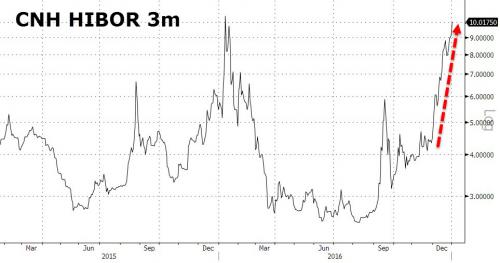Earlier today, we were surprised to note that having aggressively drained liquidity from the interbank funding market, on the first trading day of 2017, the PBOC not only fixed the Yuan well lower (sy 6.9498 vs 6.9370 on the last day of 2016, even if this was well stronger than the Offshore Yuan), but the People’s Bank of China withdrew even more liquidity. It did that by injecting CNY20 billion via 7-day reverse repos and another CNY20 billion via 14-day reverse repos in its open-market operations Tuesday, according to traders, while continuing to skip 28-day reverse repos.
The move resulted in a net drain of CNY155 billion for the day, and followed a substantial drain of a net CNY245 billion last week – the first removal of liquidity in three weeks. We promptly followed up with a warning:
PBOC drains a net CNY155 billion for the day. Keep an eye on overnight SHIBOR/ HIBOR/ Repo
— zerohedge (@zerohedge) January 3, 2017
Just over an hour later, it appears our warning was warranted, because according to the latest daily fixing of the Treasury Market Association, as a result of the PBOC’s massive liquidity drain which soaked up a nearly a third of a trillion Yuan in the past two weeks, the interbank market is freezing again as follows:
- 1-month yuan interbank rate in Hong Kong rises 1.16ppts to 13.01%,
- 3-month CNH Hibor +89bps to 10.02%;

Â
Most importantly, the overnight CNH Hibor rate soared 4.95% to 17.76%, the highest since September, andconfirming of yet another daily freeze in interbank lending simply so that the PBOC can punish all those who are still short the Yuan.Â

The good news: at least the UCD/CNH tumbled by as much as 200 pips on the session. The bad news, it is unclear how much more of this daily volatile punishment Chinese and Hong Kong banks can take.
But wait, because the interbank freeze was not all, and in a repeat of two weeks ago when China’s halted the trading of its government bond future, the Shanghai Stock Exchange announced that Shanghai halted trading of the 3.99% government bond due May 2065 after “abnormal fluctuations.” It was not exactly clear what that particular phrase meant aside from “aggressive selling” as per the chart below.

